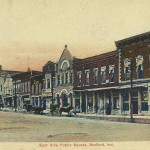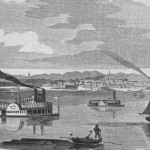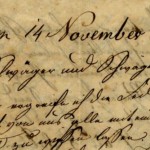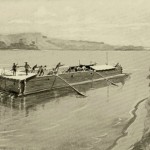The 156-mile trek west from Richmond, Indiana to Terre Haute may be made today on the same route one would have taken two hundred years ago. Though the cities are now connected by Interstate 70, drivers who’d like to do more than just get from point A to point B might consider taking the road less traveled–these days at least. The Historic National Road, which mostly follows Route 40 in Indiana, is the nation’s oldest federally funded interstate highway. Conceived of by George Washington, and mandated by congressional vote in 1806 during the presidency of Thomas Jefferson, the road was to link the Eastern Seaboard with the western interior. Alternately known as the Old Pike or the Cumberland Road–for the city where it originates in Maryland–the route traverses six states to terminate on the east side of the Mississippi, in Vandalia, Illinois.
Early on, the road began as a clearing through the forest, where trees were cut to stumps allowing the passage of Conestoga wagons. The Indiana section of the road was built between 1829 and 1834, making way for as many as 200 wagons a day. Significant commercial activity sprang up in towns along the way to accommodate the migrants’ needs. The federalist-style rowhouses are flush with the sidewalks of Centerville in Wayne County. They demonstrate the town planners’ desire to maximize exposure for the inns, groceries and blacksmith shops along what came to be known as the “Main Street of America.” Centerville, with more than 100 buildings on the National Register of Historic Places, is but one of the well-preserved sites along the living timeline that is the National Road. It’s also possible to visit the Huddleston Farmhouse Inn in nearby Cambridge City where pioneers in the mid-nineteenth century sought restoration along the way. The road remained a popular conduit for western migration through the era of canals in the 1830s and of railroads in the 1850s, to emerge as the premier transcontinental highway in the 1920s, when it was designated Route 40. Largely bypassed for the Interstate in the 1950s, in recent years the National Road has been valued anew. Recognized as a state scenic route in 1996, the Old Pike was named an All-American Road in 2002, the highest honor within the National Scenic Byways program.






















